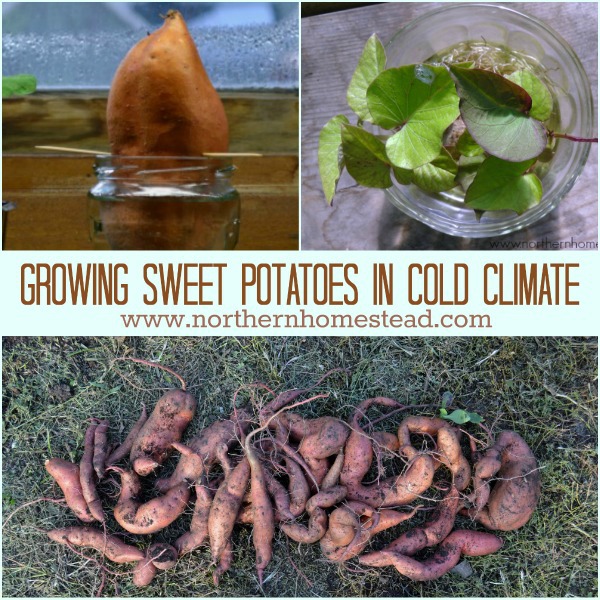 Sweet potatoes are a heat-loving summer crop. They are not suited for the northern climate, nor a short growing season. Here at Northern Homestead, we are dealing with both.
Sweet potatoes are a heat-loving summer crop. They are not suited for the northern climate, nor a short growing season. Here at Northern Homestead, we are dealing with both.
But sweet potatoes are tasty and so good for you. We love them baked with some homemade sour cream, yum.
So why not try to grow them anyway? After what I consider a successful harvest, it is time to update this post. The picture below shows one of our attempts to grow sweet potatoes – looks promising to become more, doesn’t it? It did, keep on reading.

One winter day we started talking about sweet potatoes in our local gardening group. I quickly learned that I wasn’t the only one that wants to grow them in our cool climate.
Just a side note, those local gardening groups on facebook are so valuable, if you don’t have one, start one! You will be glad you did. No one knows better how to grow than experienced gardeners in your area.
Back to sweet potatoes.
What sweet potato variety to grow
Sweet potatoes are not potatoes at all. Potatoes are from the nightshade family, sweet potatoes are from the morning glory family. There are many sweet potato varieties, but to my knowledge for short growing seasons, you can only get one.
T&T seeds offer Covington, an improved early variety that will mature in short season areas with proper care. It has bright orange flesh with beautiful, deep rose-colored skin.

I also tried a store bought organic sweet potato. I have no name for it since stores do not tell us what variety it is. However, the Covington sweet potatoes taste really good and are suited for a cold climate. It is worth it to start with them so you have potatoes to grow next year’s slips.
Where to get a sweet potato slip
Sweet potatoes are grown by slips that look very much like a seedling. Slips are grown from a mature sweet potato. You can order slips from a seed company (see above) or grow your own.
The challenge with ordering sweet potato slips from a seed company is that they ship late in the season, here in Canada in June. This is due to the sweet potato slips being extremely cold and frost sensitive, and the fact that they need to grow to a certain size before they can be shipped.
Once arrived in the mail they will often look wilted and should be placed in water to root for 4 to 5 days or be rooted in a soiled mix for 7 to 10 days. Once the plants have begun to root they can be planted outside. If you do the math, June has almost passed by now and there are less than 90 frost-free days left.
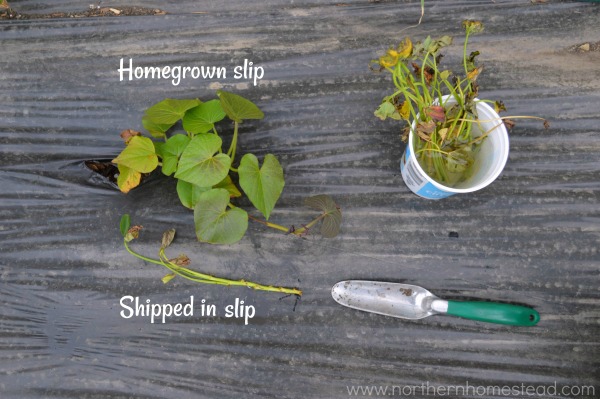
Growing your own has the advantage that you can start earlier and the slips will not have to go through a shipping shock. See picture comparison above in early June. The homegrown slips were planted according to the weather a bit earlier and are healthy plants, while the shipped in slips just arrived and are struggling to survive.
How to grow sweet potato slips
Growing your own sweet potato slips is way better than ordering them in. Plus, it is easy to do. If you have grown sweet potatoes before, save a few for seedlings. Or find an organic sweet potato you like in your local store. You will have to start growing the slips at least 3 months before you want to plant them. Late January to early February is a good time if you want to have seedlings, not just slips, at the end of May. Our growing season is very short, the only way to prolong it is up front.
The traditional way to grow sweet potato slips is to wash the sweet potato and place half of it in water, holding it above the water with some toothpicks. It kind of looks cool that way, too.
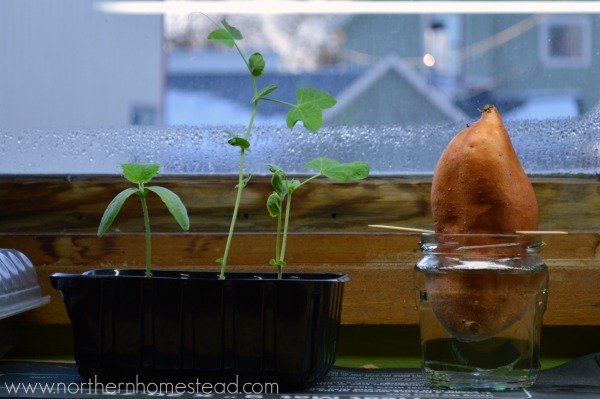
Now place the potato in a sunny window and/or under a grow light and let it grow slips till they are at least 6 inches long.

I found though that the slips grew better by laying the potato down in a tray filled with soil. I used a container without draining holes so I could water the sweet potato thoroughly. I think the very wet soil was warmer than just a glass of water, therefore the slips grew better.
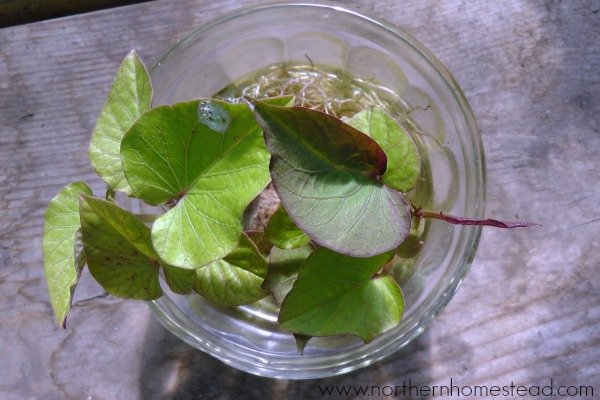
Once the slips are grown, take them off of the potato and place them in their own jar of water till they grow nice and healthy roots. Now they are ready to be planted.
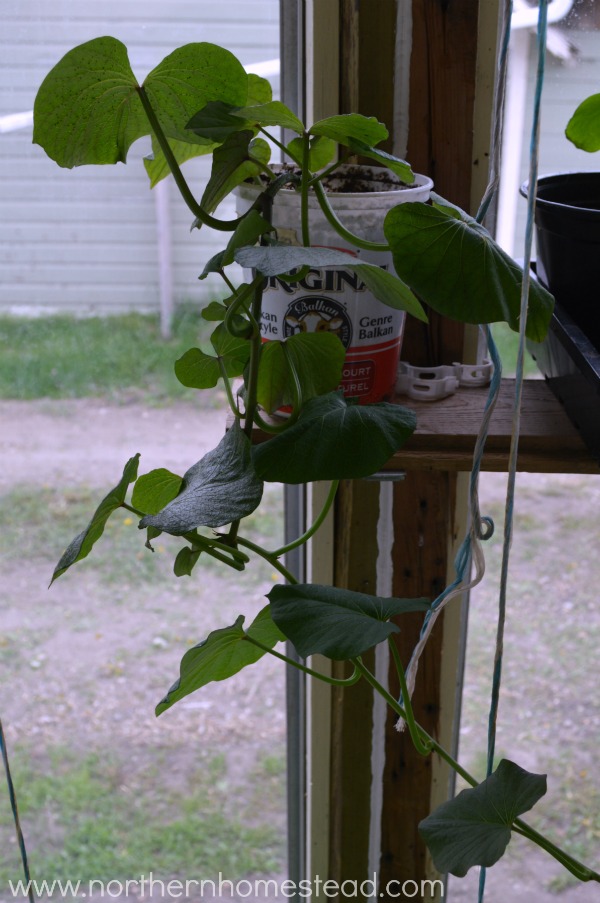
If you really want a head start on the short growing season, plant the rooted slips into a container to become a healthy plant seedling to be transplanted into the ground as soon as the weather warms up.
Planting sweet potatoes in containers
Sweet potatoes are heat loving plants. A container has the advantage that it will warm up the soil better. If you want to grow sweet potatoes in a container, plant the rooted slip into a pot or grow bag big enough to grow nice tubers. A small pot will not do.

Sweet potatoes also like loose, well-drained soil. You can use good potting soil and add some more compost to it for nutrients, or mix your own soil the Square Foot Garden way: 1/3 compost, 1/3 vermiculite, 1/3 peat moss.
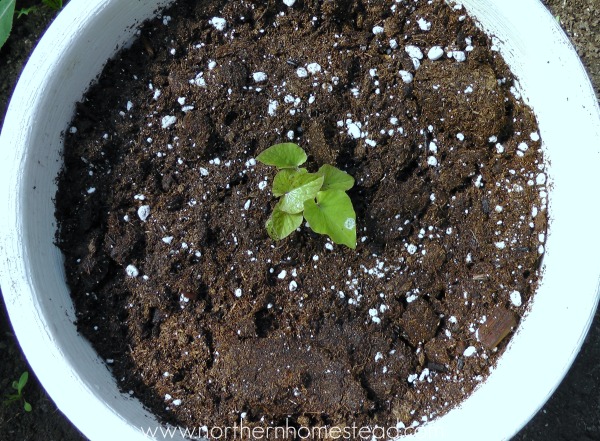
If grown in a container, give the plant enough room to grow. My first trial pot was too small (see picture above). Also, check out the grow bags that are always better for container growing.
How to plant sweet potatoes in the ground
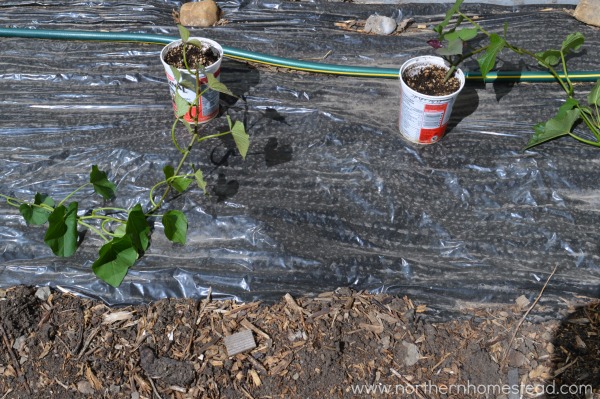
If you have a sheltered, warm location in your garden, plant the sweet potatoes directly into the ground. After trying a container, a grow bag, and the open ground, we found that we had far better results planting directly into the ground. As recommended, we planted the seedlings through black plastic mulch that I had covered the soil prior to planting to warm it up.
The soil has to be nice and loose. If you have heavy clay soil, add lots of good compost. For next year’s crop, we plan to build a raised bed. Raised beds warm up better and it is easy to have nice loose soil in them.
Give the sweet potato plant protection
Sweet potatoes love the heat of summer and do not tolerate any frost. The warmer, the better the harvest will be. In our area, heat-loving plants will need help.
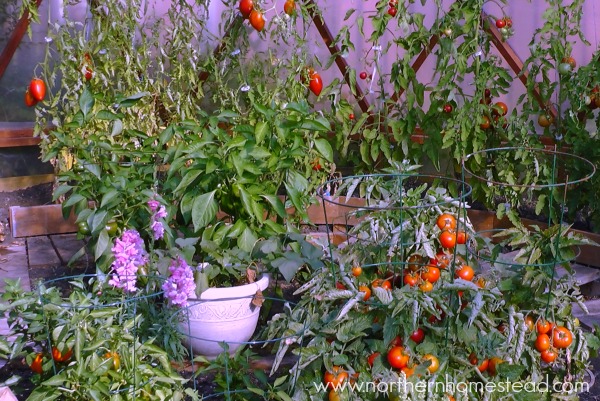
If you have a greenhouse, you can grow the sweet potatoes in there. My first try was enjoying the warmth next to tomatoes and peppers.
If you don’t have a greenhouse you can build a mini greenhouse or hoops for the plants. This is very important in the spring while plants are still young.
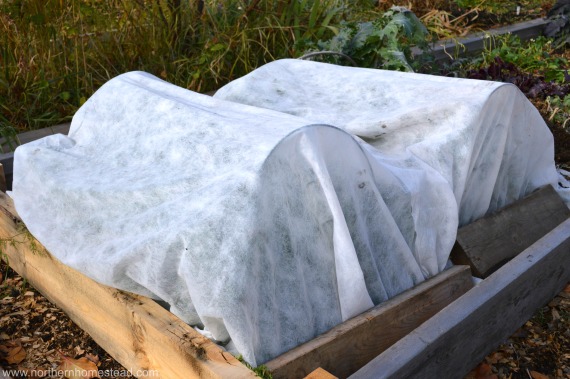
Give the plants as much protection as you can outdoors. I like the Plant Protection Blanket; it is lightweight and can be left on for days, as the weather permits. You can cover a whole bed with it, or wrap individual plants.
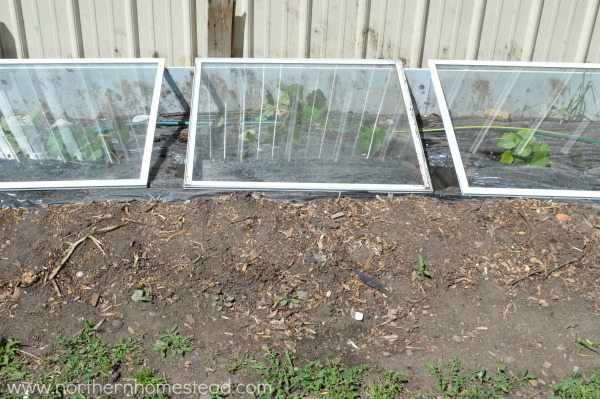
Or create a wind barrier out of recycled windows. Anything that will give the plants more heat works.
Harvest sweet potatoes
Sweet potatoes are ready to harvest when the leaves start to turn yellow. However, in our area, it is more likely that the weather will get cold. You can leave them till a light frost, but harvest before a hard frost.
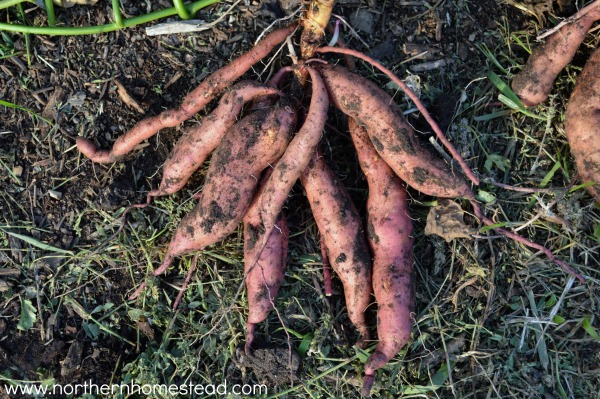
If you grew sweet potatoes in a pot, just simply empty out the pot and gather all the sweet potatoes. If grown in soil, gently dig them like you would potatoes. However, sweet potatoes are more delicate than white potatoes. They break easily and the skin at harvesting time is very thin. You might want to use a hand tool instead of a fork.
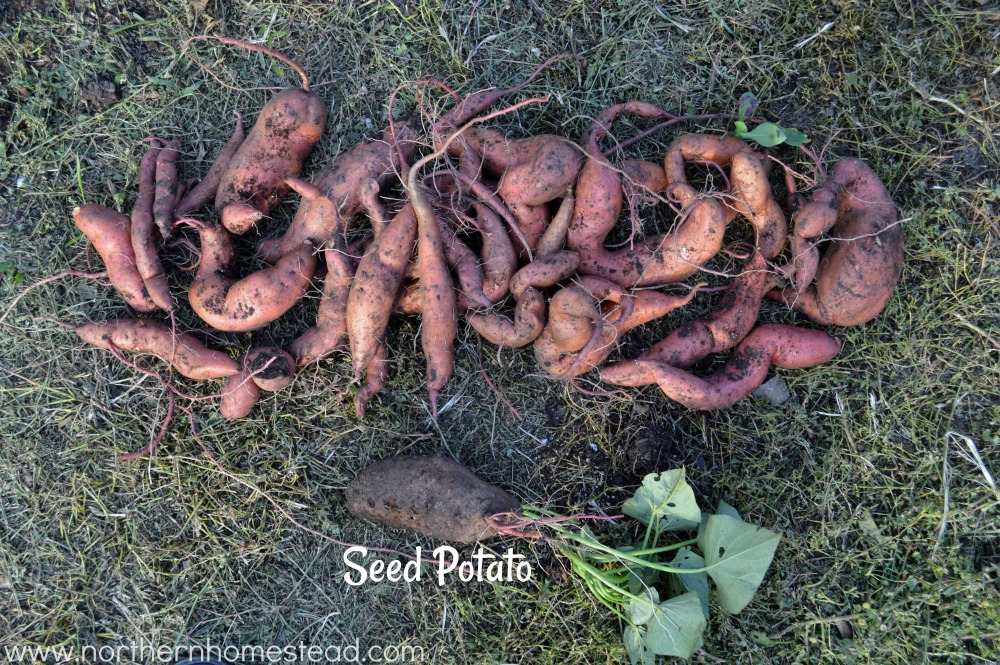
Here is the harvest from the one store-bought seed potato that we grew 4 seedlings from. Note, we also planted the seed potato itself, but it had no potatoes.
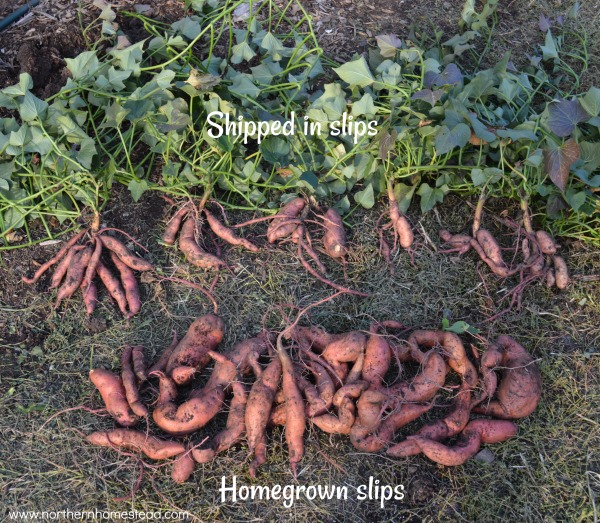
Here is a harvest comparison picture of the potatoes grown from homegrown slips vs shipped in slips. 6 slips from the order of 10 became plants and all had some potatoes.
Note, these were planted as slips, not seedlings, and also much later than my homegrown seedlings. I’m very happy with the result. It has given me enough to try them and they are delicious. Also, we got good seed potatoes for next year’s growth.
Curing and storing sweet potatoes
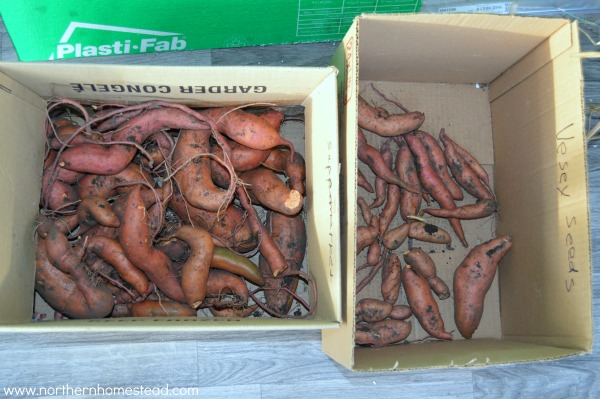
Sweet potatoes are not ready to be eaten just yet. After harvest, they need to be cured and rest for 8 weeks. After that, they will taste great and also store well.
How to cure? The ideal condition to cure sweet potatoes is a 29C (85F) degree room with 85% humidity. What? I don’t have that!
Amy at tenthacrefarm has had an easy solution for years now: take plastic grocery bags, punch some holes in them, and fill them with sweet potatoes enough so that there is just one layer of them in each bag. Tie the bags closed and put them in your sunniest, warmest window. Leave it for 10 days. If it gets chilly and your windows are drafty, put a blanket or towel over them when the sun isn’t shining.
After that, store them at temperatures around 12-15C (55 – 60F), with no light, and at around 60% humidity. You can wrap them individually, or just layer them in newspapers.
After the curing and resting period, they will taste sweeter and have a hard skin to store well for many months.
Have you grown sweet potatoes in a cold climate successfully? Please share your know-how with us. If you haven’t, maybe you want to start the adventure today!
We invite you to subscribe to Northern Homestead and follow us on Instagram, Facebook or Pinterest for the latest updates.

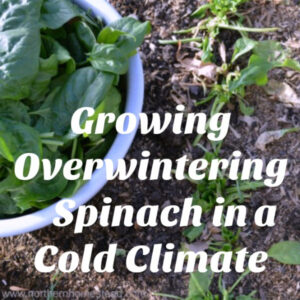
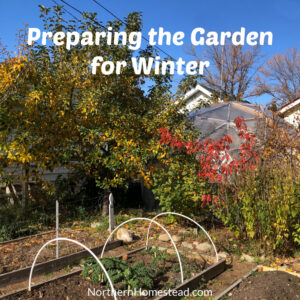



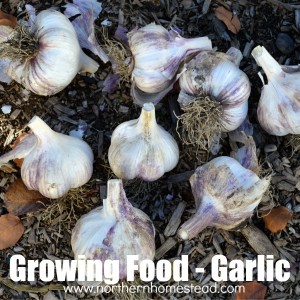
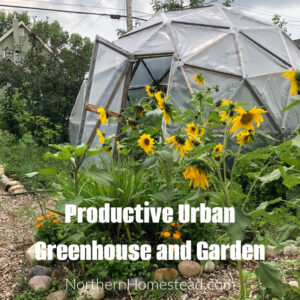

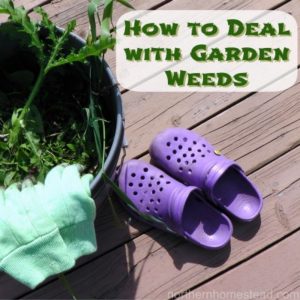
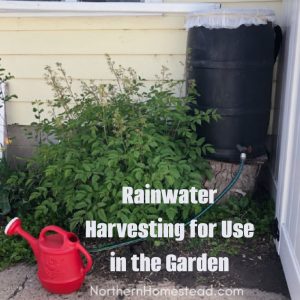

I am in southern Manitoba and I have grown sweet potatoes for the past two years from slips I started off store-bought sweet potatoes. The first year I tried to just have the nice foliage in a pot and found out in the fall that there were small sweeters at the bottom of the pot and tons of root.
I contacted our local college professor to discuss and visit their green house where they were doing sweet potato trials to see which type was best suited for Manitoba growing. I haven’t heard the results but it was very interesting!
Last summer I tried a few home-grown slips in my main garden. The foliage was great, however, the harvest was not as good as I wanted. Still, as you know, there’s nothing like a homegrown sweet potato.
It’s uncertain this year, as it’s only January, if I will try sweet potatoes again but I don’t have any rooting in water yet either. Even though I have a large garden, I’m not sure if I want to give up the space it took to try the sweet potatoes again.
I don’t know what your summer weather is like but our weather is all over the map these last few years.
One question I have is, did your sweet potato plants flower at all? My trials did not have any flowers. Not one.
Thanks for the post. Good to hear more people are trying crops in the chill of Canada.
Thank you for sharing your experience, Rhonda. No my did not bloom. I think the time was way to short. I planted them in June, and that is to late for us, since our fall comes early. I plan on starting earlier with protection. I’m learning that sweet potatoes do not like heavy soil. In Canada most of our soil is heavy. That might have been your problem to get a great harvest. Something to think about.
Hi Rhonda,
The new variety was just released this Spring (2019) and is called VS Radiance. Sagegarden.ca still had a few slips to sell. Thanks for the interesting post Anna,
I believe it is a patented variety.
Hi
Last year I planted sweet potoatoes and then took some slips from the plants and put the slips in a water containers. They were doing very good but now the leaves are turning yellow. Please can you let me know or should I put in a container in my basement until spring.
Thanks
Almas nathoo
Glad to heat they did well for you. You can plant them in a small container in the house. You would at least keep them alive and get more slips to grow this summer.
I grow more slips by cutting each kumara (sweet potato) in half long-ways, then soaking them all (flat side down) in a plate of water together. I need to re-fill the plate with water daily to keep them hydrated.
Great tip Karen, thank you!
Just discovered your amazing and informative website. Too bad it’s covered in ads. Seems hypocritical to be of the homesteading variety, when your website is pushing products that the 21st century could do without.
Everyone has bills, the ads are a necessary evil.
I love the articles. Thanks.
Thank you Julie for your understanding.
I just ignore the ads. At least they don’t cover the words, as the ads on some pages do. THAT is irritating!
Very nice article, thank you. I live in Pennsylvania in the US. Not as northern as you, but zone 6B. Still, not a Southern, typical sweet potato climate. We seem to have a nice harvest, but when I read about the 85-90 deg. F curing… my heart sank… until I found this article. I will definitely do the plastic bag thing. So excited, thanks again.
If you are looking for slips for short season varieties of sweet potatoes, do be sure to check the Mapple Farm brochure at Mapplefarm.com. They grow 10 or more kinds and are located in NB. I used to get slips from them when then shipped slips to U.S., no longer do that. I can still get their seeds, though. They grow what seeds and slips they sell, and all cool/short season adapted. Wonderful stuff.
Hello, your post was just what I was looking for! I too had the oh-oh moment after I dug my sweet potatoes yesterday and went online to find out if they needed to be cured & how. Michigan’s Upper Peninsula is only 80 and sunny at some points in the summer and our house is now at 65 with the heat on in October. I’m going to give the plastic bags a try, though we don’t have much sun coming up this week. I had put them in a box near a heater vent yesterday, but that would tend to dry them out. I had no idea they needed a high heat and humidity curing–should have checked that out first!
We are zone 4a/4b mostly due to being just a few blocks in from Lake Michigan on the southern edge of the Upper Peninsula, otherwise zone 3 in most of the central U.P. I’ve tried sweet potatoes before in the ground without much luck but this year I put four rooted/potted plants (from the garden center, not sure what variety), in two black plastic large pots (approx. 20″ across) and set the pots on the edge of the asphalt driveway bordering the back lawn for extra warmth, plus we had a warm summer too. That seemed to do the trick because I got about 15 pounds of them all total from the $4.97 purchase cost and we pay well over a dollar a pound up here for them in the store, about .99 per pound on sale. If I can find the plants next year I will put each plant singly in pots though, planting right in the center, instead of 2 per pot as there are some curvy sweet potatoes from growing around the sides of the pot! I did notice that they didn’t grow to any great depth though, so old washtubs would work great I think.–wider but shallower. They will all taste good regardless of shape though and some of them are enough for 2-3 servings each. Very happy with results!
I also often grow okra under clear plastic tunnels until mid-summer and get enough for a few meals of fried okra plus some for gumbos–nothing outstanding but it’s also very hard to find in good fresh shape here in the U.P. I use the fastest maturing date seeds, which have gotten much better in recent years than the traditional Clemson Spineless. Annie Oakley variety has proven to do the best for me here in the far North, with some success with Lee variety also. Thanks for the sweet potato info!
Your success growing sweet potatoes in the U.P. is inspiring me to give it a go next year. I have a greenhouse, & I think I will build a raised bed & string & clip the vines up like I do my cucumbers and tomatoes. Have you seen that style of growing? I wonder if the vines will be happy clipped up that way.
You can train the vines up, and even trim them back if they get too big.
I have tried growing sweet potatoes three years in a row. Only had success the first year when we had rain and a really hot summer. Thanks for all your tips, going to try again. Im in southern Saskatchewan. Have my tubers in water on the window sill already. Will root the slips and plant them in pots for the spring. I have tried them in the garden and pots, both have the same amount of minimal success. What makes me continue trying? I love how they taste from the garden.
Good for you to keep trying. I think starting them in pots could make a difference for you. We also water ours.
We’ve had luck in upstate NY. This was our third year growing from our own slips. We use the largest potatoes for slips and this year our potatoes were enormous and we harvested 150 lbs. I also experimented with planting next to onions to dissuade rodents. We’ve been using clear plastic as a ground covering (it gets hotter than black plastic) and I think this makes a difference, though I am not happy about using single use plastic, so may try using low hoops with reusable greenhouse plastic this year and see how that works. For curing– we used plastic crates and stacked them in an unused (clean) bathroom and put a space heater and humidifier for two weeks.
Happy to hear it works so well for you. We have used weed control fabric as mulch for corn, it worked well and could be reused. I can see how clear plastic would worm up the soil more. There is a biodegradable clear plastic mulch film that organic growers use.
I might try hardening them off using a glass aquarium with a small silicone heating pad 60 watt, or so, available from Napa, for cars. Humidity would be easier to maintain in a small container.
That might be a great idea for those that have one, thank you for sharing.
I have an old electric stove/oven but you can use an old fridge as well. Put a 13 watt LED or 15 Incandescent light inside along with a pan of water and close the door on the appliance (I use an inkbird temperature controller but you can just use a thermometer) and the temperature sits nicely at 85-90 degrees F. You could also use a large picnic cooler, anything with insulation. Even a cardboard mealkit box from Goodfood would work.
I live in Buffalo with a sunny, protected backyard. For a few years, I have been growing sweet potatoes, both from the grocery store and a slip I bought at a home improvement store. Normally, I will overwinter a few slips in water and they do well, but this last year my last two sweet potatoes sprouted! Which was a good thing because my cat ate the slips…
Each year, I amend my compost for sweet potato success and place the slips in a 15-20 gallon pot. I put it out in the spring during the day and bring it in at night until the temperatures are ideal.
When fall hits, I do the same again- inside at night and out during the day.
Following this process, I can get seven months of growing out of the little buggers!
This year, I was fortunate enough to see several beautiful blooms- but no seeds. I’m hoping some day to get seeds just to see what comes up!
Two years ago my regular potatoes produced seeds- I was blessed with ity bity potatoes from the seeds. I used them as seed potatoes this year, so we’ll see what I get!
My flowered one year too, so I thought we would have a lot bigger harvest, that was not the case though.
We want to expand our production. How many slips did you get per sweet potatoe? Ours are quite large saved from last year and just trying ro decide how many to try and slip.
It really depends on the potatoes how many slips you get. Just like with real potatoes, some have many eyes and some not so many. Except for the sweet potatoes eyes are not as visable. You can however cut a long slip into smaller to make more, and root them all.
Hi- did you cut the potatoes in half before you lay them in the dirt, or no? It wasn’t mentioned.
Sue
No, those are whole sweet potatoes.
Thank you !!
I have a late start this year on my sweet potatoes. I first tried to locate slips with no luck, so I went to the local international grocery store and picked a few and tried some in water and some in soil. The ones in water went bad and the had one in soil grew a few small slips and then started to go bad. I took those and planted in the prepared container with compost, peat moss and my soil blend. From seven little ones some larger than others. Several had the leaves turn brown and fail off and died. Three came back and one is doing very well another is right behind and the other had been eaten by a rabbit or squirrel but is trying to come back. I tried some others in a hot humid dark area and had no luck, I change to a larger container with soil and more sweet potatoes, and they are doing better. I created another container for more slips and just planted them the other day. My concern is they say it takes 90 plus days to grow. When does that date start? Is that when I see growth from them in the container bed or right after they are planted? My slips going in have been 4 to 6 inches not really large. The 90 days is going to put me into October from planting if it’s from a later time in the plants stage that could easily put me into November or later? If we get cold or cold and snow in October or early November, I am trying to figure out what is my best option? Green House that still get cold inside specially at night or bring in garage or some other place to finish out the time? any advice or help on this would be great. Thank you
The days to maturity usually count from transplanting and mean perfect growing condition days. So if you had a setback, those days are lost so to speak.
I’m actually in northeast Georgia so I probably don’t really belong in this thread but found your post because I got a late start with my sweet potatoes (my first attempt) and just harvested them today, 10-5-2022. I’m not even sure when this post was published so I’m not sure if it’s current or not. But our temps are unfortunately already past the optimum temps for curing. I guess I will try your plastic bag suggestion but a truly sunny window is going to be a challenge. How many hours of sun would you say they need? Thank you.
Everyone belongs here, Lila. I have no answer to your question though. Personally, I would not stress about hours or so. Just do the best you can, they will be delicious.
Where can I buy sweet potato seed, not slips. I can’t find them.
For my knowledge sweet potatoes are only grown from slips not seeds.
Hi Folks,
Renee, did you buy and plant the VS Radiance slips? If you did, what was your experience like? I am giving mail order Radiance slips a shot this year along with homegrown stokes and jewel slips (in Vancouver). We’ll see how it goes.
Thanks for providing so much information Anna.
Greg
Wi did one year buy slips, through shipping they were weakened. Growing our own had the advantage that we could start earlier and plant them into a pot before danger of frost was over. In Vancouver things are different of course, since you can plant earlier and harvest later. Good luck with your experiments.